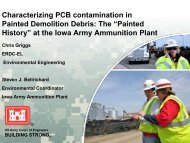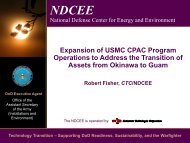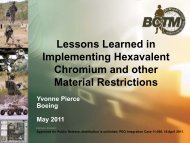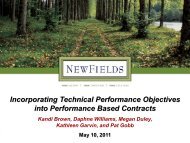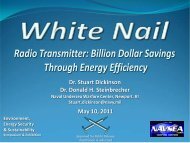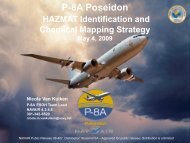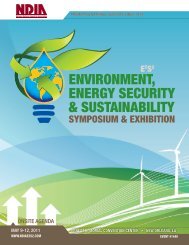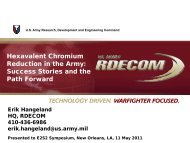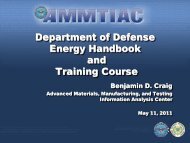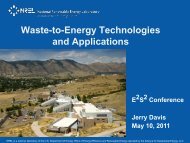9688 - E2S2
9688 - E2S2
9688 - E2S2
Create successful ePaper yourself
Turn your PDF publications into a flip-book with our unique Google optimized e-Paper software.
Geothermal Energy<br />
Demonstration<br />
at Fort Indiantown Gap<br />
DoD Executive Agent<br />
Office Office of the of the<br />
Assistant Assistant Secretary<br />
of the of Army the Army<br />
(Installations and and<br />
Environment)<br />
Michelle Golesich, NDCEE/CTC<br />
Heidi Kaltenhauser, NDCEE/CTC<br />
The NDCEE is operated by:<br />
Technology Transition – Supporting DoD Readiness, Sustainability, and the Warfighter
National Guard Energy Awareness<br />
• Pennsylvania National Guard (PANG) is seeking to:<br />
– Reduce energy consumption<br />
– Reduce use of fossil fuels<br />
– Become energy independent<br />
– Increase use of sustainable<br />
energy technology<br />
• Challenges faced by PANG include:<br />
– Higher energy costs as a result<br />
of price rate increases<br />
– Outdated facilities, 50+ years<br />
– Lack of funding for repairs<br />
and renovations.<br />
National Defense Center for Energy and Environment<br />
2<br />
<strong>E2S2</strong> Conference – June 2010
Demonstration Site<br />
• Fort Indiantown Gap (FTIG) was chosen as the location<br />
for an alternative energy technology demonstration.<br />
– Largest PANG installation<br />
– 17,000 acres and 140 training<br />
areas and facilities<br />
– Provides year-round training<br />
for military forces, law<br />
enforcement agents, and<br />
civilians<br />
National Defense Center for Energy and Environment<br />
3<br />
<strong>E2S2</strong> Conference – June 2010
Demonstration Site (continued)<br />
• Selected buildings 4-201 & 4-202 for demonstration<br />
– 4-201 selected for geothermal installation<br />
– 4-202 selected for energy consumption baseline comparison<br />
‣ Identical design/construction –<br />
provides good energy comparison<br />
‣ Open floor plan – each is<br />
approximately 4,890 square feet in<br />
size<br />
‣ Recently constructed – May 2008<br />
‣ Features updated energy-efficient<br />
fixtures – programmable<br />
thermostats<br />
‣ Used for Soldier Readiness<br />
Processing (SRP) by units<br />
departing and returning from<br />
military deployments<br />
National Defense Center for Energy and Environment<br />
4<br />
<strong>E2S2</strong> Conference – June 2010
Technology Assessment<br />
• Conducted technology assessment in October 2008.<br />
• Identified alternative technology options.<br />
National Defense Center for Energy and Environment<br />
5<br />
<strong>E2S2</strong> Conference – June 2010
Geothermal Heat Pump System<br />
• Recommended geothermal heat pump system as the<br />
most economically viable system<br />
– Selected closed loop vertical<br />
well system<br />
– Takes advantage of seasonal<br />
temperature differences between<br />
air and ground temperature<br />
– Moves heat from ground to building<br />
in winter and from building to<br />
ground in summer<br />
Diagram courtesy of EERE.<br />
National Defense Center for Energy and Environment<br />
6<br />
<strong>E2S2</strong> Conference – June 2010
Demonstration Goals<br />
• Evaluate life-cycle cost of ground-source heat pump<br />
heating/cooling systems<br />
– Determine savings from reduced propane usage<br />
• Evaluate environmental benefits<br />
of ground-source heat pump<br />
system compared to propane<br />
gas heating and electric air<br />
cooling system<br />
National Defense Center for Energy and Environment<br />
7<br />
<strong>E2S2</strong> Conference – June 2010
Demonstration Well DrillingGoals<br />
• Installed 8-ton geothermal system outside of building<br />
4-201 in April 2009<br />
- Installation included the drilling of 6 wells at an average<br />
depth of 220 ft and piping connected to building 4-201.<br />
National Defense Center for Energy and Environment<br />
8<br />
<strong>E2S2</strong> Conference – June 2010
Heat Pump Installation<br />
- Heat pump system replaced the conventional HVAC system.<br />
- Propane backup heater was kept in building 4-201 for use<br />
during geothermal startup.<br />
National Defense Center for Energy and Environment<br />
9<br />
<strong>E2S2</strong> Conference – June 2010
System Commissioning<br />
• Entire system was commissioned in July 2009.<br />
- Duct work was evaluated for<br />
proper air flow.<br />
- Electrical panels were configured<br />
for metering/monitoring.<br />
National Defense Center for Energy and Environment<br />
10<br />
<strong>E2S2</strong> Conference – June 2010
Data Collection<br />
• Data collecting software was installed on laptops placed at<br />
each location.<br />
– Laptops are collecting electrical information from the electrical<br />
panels in each building.<br />
National Defense Center for Energy and Environment<br />
11<br />
<strong>E2S2</strong> Conference – June 2010
Data Collection (continued)<br />
• Electrical data will record:<br />
– Voltage<br />
– Current<br />
– Kilowatt.<br />
• Additional collected information includes:<br />
– Occupancy schedules of buildings<br />
– Weather/temperature information of FTIG.<br />
National Defense Center for Energy and Environment<br />
12<br />
<strong>E2S2</strong> Conference – June 2010
Current Results<br />
Average monthly<br />
temperatures at FTIG:<br />
Average occupancy of<br />
Buildings 4-201 and 4-202:<br />
National Defense Center for Energy and Environment<br />
13<br />
<strong>E2S2</strong> Conference – June 2010
Current Results (continued)<br />
As of December 2009, PANG saved<br />
over 600 gallons of propane by using<br />
the geothermal heat pump system.<br />
• The propane savings is even greater considering the<br />
extensive use of building 4-201 compared to 4-202.<br />
• A more accurate volume of propane usage will be<br />
calculated at the end of the technology<br />
demonstration.<br />
National Defense Center for Energy and Environment<br />
14<br />
<strong>E2S2</strong> Conference – June 2010
Conclusions<br />
• Electrical data is being collected monthly through August<br />
2010.<br />
• Period of performance was extended so that one full<br />
year of data could be gathered.<br />
– A full year of monitoring provides both summer and winter<br />
data – seasons when the geothermal heat pump will be<br />
heavily utilized.<br />
• Upon completion of demonstration:<br />
– Collected data will be analyzed<br />
– Cost benefit analysis will be developed.<br />
• Demonstration findings will be used by PANG and other<br />
National Guard entities to determine the feasibility of<br />
implementing the technology regionally.<br />
National Defense Center for Energy and Environment<br />
15<br />
<strong>E2S2</strong> Conference – June 2010
Path Forward<br />
• Follow-on geothermal project has started at FTIG<br />
• Include design of 3 rd building similar in design to<br />
buildings 4-201 and 4-202<br />
– LEED Silver Certified<br />
– Energy efficient features<br />
– Installation of geothermal heat pump system<br />
• Will use 4-201 and 4-202 as baseline comparisons<br />
– 4-201 – baseline<br />
– 4-202 – with geothermal<br />
– 3 rd building – LEED with geothermal<br />
Image courtesy of USGBC.<br />
National Defense Center for Energy and Environment<br />
16<br />
<strong>E2S2</strong> Conference – June 2010
Points of Contact<br />
Ms. Michelle Golesich<br />
NDCEE/CTC<br />
golesicm@ctc.com<br />
(814) 269-2676<br />
DoD Executive Agent<br />
Office of the<br />
Assistant Secretary<br />
of the Army<br />
(Installations and<br />
Environment)<br />
www.ndcee.ctc.com<br />
Mr. Monsoor Rashid<br />
National Guard Bureau<br />
monsoor.rashid@us.army.mil<br />
(703) 607-7976<br />
Mr. Ray Hulings<br />
PANG<br />
rhulings@state.pa.us<br />
(717) 861-2158<br />
This work was funded through the Office of the Assistant Secretary of the Army<br />
(Installations and Environment) and conducted under contract W74V8H-04-D-0005 Task<br />
0501. The views, opinions, and/or findings contained in this paper are those of the<br />
author(s) and should not be construed as an official Department of the Army position,<br />
policy, or decision unless so designated by other official documentation.<br />
National Defense Center for Energy and Environment<br />
17<br />
<strong>E2S2</strong> Conference – June 2010



